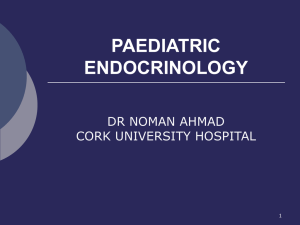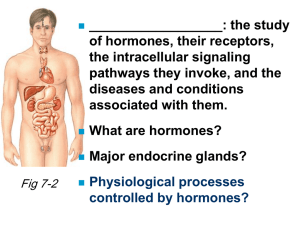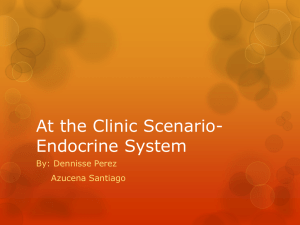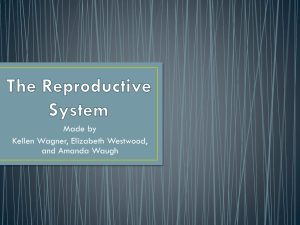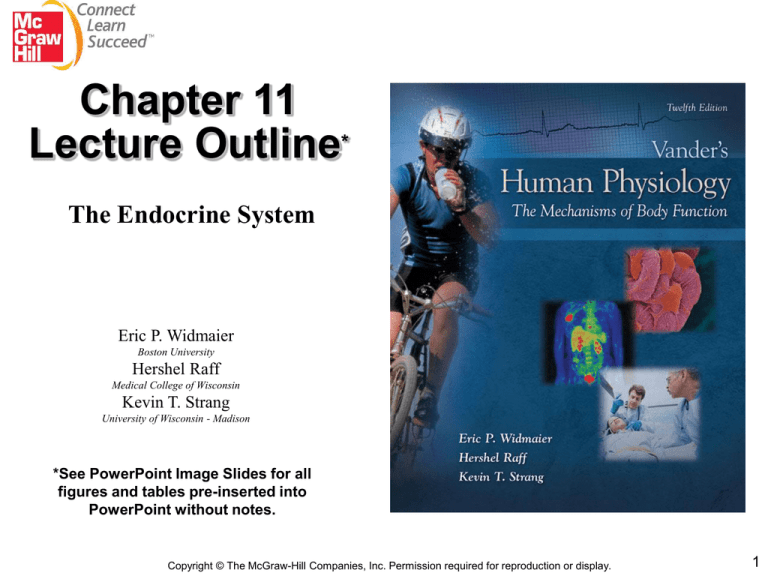
Chapter 11
Lecture Outline*
The Endocrine System
Eric P. Widmaier
Boston University
Hershel Raff
Medical College of Wisconsin
Kevin T. Strang
University of Wisconsin - Madison
*See PowerPoint Image Slides for all
figures and tables pre-inserted into
PowerPoint without notes.
Copyright © The McGraw-Hill Companies, Inc. Permission required for reproduction or display.
1
Fig. 11-1
2
Hormones Structures and Synthesis
• Three major chemical classes of hormones
– Amines
– Peptides and proteins
– Steroids
3
Amine Hormones
Fig. 11-2
4
Peptide and Protein Hormones
Fig. 11-3
5
Steroid Hormones
Fig. 11-4
6
Steroid Hormone Synthesis
Fig. 11-5
7
Adrenal Gland Hormones
Fig. 11-6
8
Synthesis of Sex Hormones
Fig. 11-7
9
Hormone Transport in the Blood
10
Hormone Metabolism and Excretion
Fig. 11-8
11
Permissive Actions of Hormones
Fig. 11-9
12
Hormone Receptors
• The ability of a cell to respond to a hormone
depends upon the presence of receptors for that
hormone on or in the target cell.
• An increase in the number of receptors for a
hormone is called up-regulation.
• A decrease in the number of receptors for a
hormone is called down-regulation.
13
Events Elicited by HormoneReceptor Binding
14
Pharmacological Effects of Hormones
• Administration of large quantities of a
hormone for medical purposes may have
effects in an individual that are not usually
seen in a healthy person.
15
Inputs that Control Hormone Secretion
Fig. 11-10
16
Control by Plasma Concentrations of Mineral
Ions or Organic Nutrients
Fig. 11-11
17
Control by Neurons
Fig. 11-12
18
Control by Other Hormones
• A hormone that controls the secretion of
another hormone is called a tropic hormone.
19
Types of Endocrine Disorders
• Hyposecretion: the secretion of too little
hormone.
• Hypersecretion: the secretion of too much
hormone.
• Hyporesponsiveness and Hyperresponsiveness
occurs when the target cells do not respond
properly to a hormone.
20
The Hypothalamus and Pituitary Gland
Fig. 11-13
21
Control Systems
Involving the
Hypothalamus and
Pituitary
Fig. 11-14
22
Posterior Pituitary Hormones
• The posterior pituitary does not synthesize any
hormones; it only secretes them.
• Oxytocin is involved in the milk ejection reflex of
nursing mothers and emotional bonding.
• Antidiuretic hormone (Vasopressin) is involved in
regulation of water balance and osmolarity.
23
Fig. 11-15
24
Anterior Pituitary Hormones and the Hypothalamus
Fig. 11-17
25
Fig. 11-19
26
Feedback Loops
Fig. 11-20
27
The Thyroid Gland
Fig. 11-21
28
Synthesis of Thyroid Hormones
Fig. 11-22
29
Control of
Thyroid
Function
Fig. 11-23
30
Actions of Thyroid Hormones
• Metabolic Actions
• Permissive Actions
• Growth and Development
31
The Endocrine Response to Stress
• The endocrine system responds to stresses on
the body such as trauma, infection, pain, sleep
deprivation, fright, and other emotional
stresses by increasing the release of cortisol
from the adrenal cortex and epinephrine from
the adrenal medulla.
32
Physiological Functions of Cortisol
• Permits action of epinephrine and norepinephrine on
muscles and blood vessels.
• Maintains cellular concentrations of metabolic
enzymes required to produce glucose between meals.
• Decreases events associated with the inflammatory
response such as capillary permeability and
production of prostaglandins.
• Important for fetal development.
33
34
Other Hormones Released During Stress
• Aldosterone, vasopressin, growth hormone,
glucagon, beta-endorphin.
• Fight-or-flight response: epinephrine and
norepinephrine.
35
Adrenal Insufficiency and Cushing’s
Syndrome
• The general term for any situation in which plasma levels of
cortisol are chronically lower than normal is adrenal
insufficiency.
• Patients with adrenal insufficiency suffer from a diffuse array of
symptoms, depending on the severity and cause of the disease,
including: weakness, lethargy, and loss of appetite.
• Examination may reveal low blood pressure (in part because
cortisol is needed to permit the full extent of the cardiovascular
actions of epinephrine) and low blood sugar, especially after
fasting (because of the loss of the normal metabolic actions of
cortisol).
36
Adrenal Insufficiency and Cushing’s
Syndrome
• Primary adrenal insufficiency is due to a loss of adrenal cortical
function, as may occur, for example, when infectious diseases
such as tuberculosis infiltrate the adrenal glands and destroy them.
• The adrenals can also (rarely) be destroyed by invasive tumors.
• Most commonly the syndrome is due to autoimmune attack
causing the destruction of many of the cells of the adrenal glands.
• Because of this, all of the zones of the adrenal cortex are affected.
Thus, not only cortisol but also aldosterone levels are decreased
below normal in primary adrenal insufficiency.
37
Adrenal Insufficiency and Cushing’s
Syndrome
• This decrease in aldosterone concentration creates the additional
problem of an imbalance in Na+, K+, and water in the blood
because aldosterone is a key regulator of those variables.
• The loss of salt and water balance may lead to hypotension (low
blood pressure).
• Primary adrenal insufficiency from any of these causes is also
known as Addison’s disease.
38
Adrenal Insufficiency and Cushing’s
Syndrome
• Adrenal insufficiency can also be due to a deficiency of
ACTH—secondary adrenal insufficiency—which may
arise from pituitary disease.
• Its symptoms are often less dramatic than primary
adrenal insufficiency, because aldosterone secretion,
which does not rely on ACTH, is maintained by other
mechanisms.
• Adrenal insufficiency can be life-threatening if not
treated aggressively.
39
Adrenal Insufficiency and Cushing’s
Syndrome
• In Cushing’s Syndrome, there is excess cortisol in the
blood, even in the nonstressed individual.
• The cause may be a primary defect (e.g., a cortisolsecreting tumor of the adrenal) or may be secondary
(usually due to an ACTH-secreting tumor of the pituitary
gland).
• In Cushing’s disease (secondary) the increased blood
levels of cortisol tend to promote uncontrolled
catabolism of bone, muscle, skin, and other organs.
40
Adrenal Insufficiency and Cushing’s
Syndrome
• In Cushing’s Syndrome problems include:
– Osteoporosis
– Muscles weakness
– Blood sugar increases to levels observed in diabetes mellitus
– Immunosuppression
– Redistribution of fat (buffalo hump and moon face)
– Hypertension (high blood pressure)
• Treatment of Cushing’s Syndrome depends on the cause.
– Surgical removal of the pituitary tumor
– Adrenalectomy
41
Endocrine Control of Growth
• At least a dozen hormones directly or
indirectly play important roles in controlling
growth.
42
Bone Growth
Fig. 11-27
Fig. 11-26
43
Environmental Factors Influencing Growth
• Insufficient amounts of amino acids, fatty
acids, vitamins, or minerals interferes with
growth.
44
Hormonal Influences on Growth
• Growth hormone and Insulin-like growth
factors
• Thyroid hormones
• Insulin
• Sex hormones (testosterone, estrogen)
• Cortisol
45
Fig. 11-28
46
47
48
Parathyroid Hormone
• Parathyroid hormone (PH) is secreted by the
parathyroid glands (4 glands located in the
neck on the thyroid gland).
• PH is critically important to regulation of
Calcium levels.
49
Fig. 11-31
50
Parathyroid
Hormone
Fig. 11-32
51
Endocrine Control of Ca2+ Homeostasis
• Ca2+ homeostasis is so vital that the absence of
the hormones for its control would be
catastrophic.
• This is a highly regulated and finely balanced
system involving several hormones.
52
Effector Sites for Calcium Homeostasis
• Calcium storage, absorption into the body and
excretion from the body occur at 3 main sites:
• Bone
• Kidneys
• Gastrointestinal Tract
53
Hormonal Controls
• Two major hormones regulate plasma calcium
concentration:
– Parathyroid hormone
– 1,25-dihydroxyvitamin D
• Calcitonin plays a limited role.
54
1,25-Dihydroxyvitamin D
Fig. 11-33
55
Calcitonin
• Calcitonin, which is secreted by parafollicular
cells of the thyroid gland, decreases plasma
calcium concentration by inhibiting
osteoclasts.
• Its secretion is stimulated by high plasma
calcium concentration, and it is only a factor
when the concentration is very high.
56
Metabolic Bone Diseases
• Rickets (in children) and osteomalacia (in adults) are conditions
in which mineralization of bone matrix is deficient, causing the
bones to be soft and easily fractured. A major cause of rickets and
osteomalacia is deficiency of vitamin D.
• Osteoporosis (an imbalance between bone resorption and bone
formation) resulting in decreases in bone mass and strength leads
to an increased incidence of fractures.
• Osteoporosis can occur in people who are immobilized, in people
who have an excessive plasma concentration of a hormone that
favors bone resorption, and in people who have a deficient plasma
concentration of a hormone that favors bone formation.
57
Metabolic Bone Diseases
• Osteoporosis is most commonly seen with aging.
• Everyone loses bone with age, but osteoporosis is more
common in elderly women than in men for several
reasons:
– Women have a smaller bone mass to begin with
– The loss that occurs with aging occurs more rapidly
(menopause removes the bone-promoting influence of
estrogen)
– Pregnancy
• Prevention is the focus of attention for osteoporosis.
58
Metabolic Bone Diseases
• Treatment options for osteoporosis:
–
–
–
–
Treatment of postmenopausal women with estrogen
A regular weight-bearing exercise program
Adequate dietary Ca2+ and vitamin D intake
Drugs, called bisphosphonates, that interfere with the
resorption of bone by osteoclasts
– Other antiresorptive substances include calcitonin and
selective estrogen receptor modulators (SERMs), which act
by interacting with estrogen receptors, compensating for the
low estrogen after menopause.
59
Hypercalcemia
• Hypercalcemia is abnormally high levels of Ca2+ levels in
the blood.
• Cause of hypercalcemia:
Primary hyperparathyroidism (caused by a benign tumor in
one of the four parathyroid glands)
– Certain types of cancer can lead to humoral hypercalcemia of
malignancy.
– Excessive ingestion of vitamin D can lead to hypercalcemia
despite the fact that PTH levels will be very low.
–
• Hypercalcemia symptoms:
– Tiredness
– Lethargy with muscle weakness
– Nausea and vomiting (due to effects on the GI tract)
60
Hypocalcemia
• Hypocalcemia is abnormally low levels of Ca2+ levels in the
blood.
• Causes:
– Primary hypoparathyroidism: loss of parathyroid gland function
– Pseudohypoparathyroidism: resistance to the effects of PTH in target
tissue, even though PTH levels in the blood tend to be elevated
– Secondary hyperparathyroidism: failure to absorb vitamin D from the
gastrointestinal tract, or decreased kidney 1,25-(OH)2D production, which
can occur in kidney disease
• The symptoms of hypocalcemia are:
– Increases the excitability of nerves and muscles (seizures, muscle spasms
(hypocalcemic tetany), and nerve excitability)
• Treatment:
– Calcium salts and 1,25-(OH)2D (calcitriol), supplemental dietary Ca2+ and
high doses of dietary vitamin D, injections of vitamin D
61



